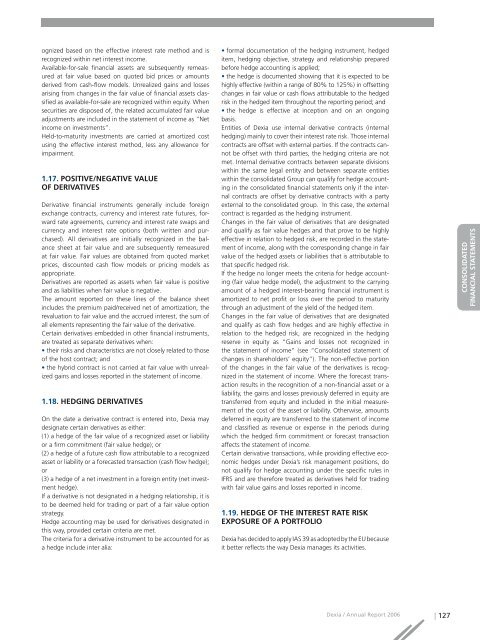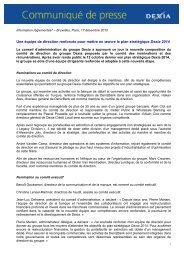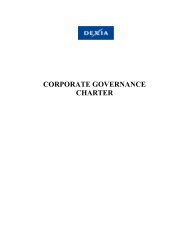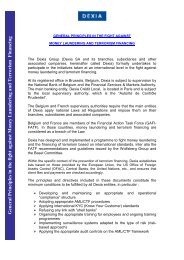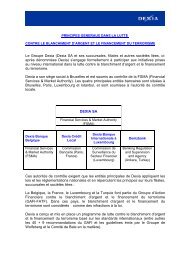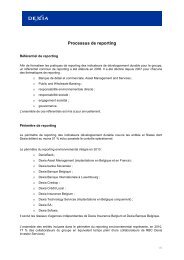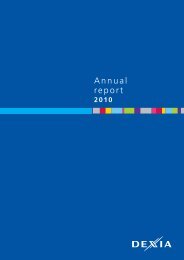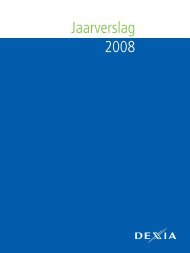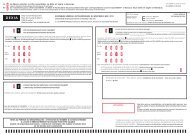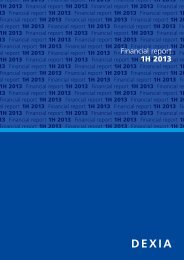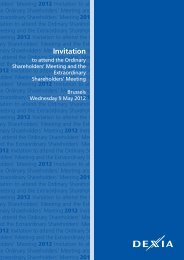Annual report 2006 - Dexia.com
Annual report 2006 - Dexia.com
Annual report 2006 - Dexia.com
Create successful ePaper yourself
Turn your PDF publications into a flip-book with our unique Google optimized e-Paper software.
ognized based on the effective interest rate method and is<br />
recognized within net interest in<strong>com</strong>e.<br />
Available-for-sale financial assets are subsequently remeasured<br />
at fair value based on quoted bid prices or amounts<br />
derived from cash-flow models. Unrealized gains and losses<br />
arising from changes in the fair value of financial assets classified<br />
as available-for-sale are recognized within equity. When<br />
securities are disposed of, the related accumulated fair value<br />
adjustments are included in the statement of in<strong>com</strong>e as “Net<br />
in<strong>com</strong>e on investments”.<br />
Held-to-maturity investments are carried at amortized cost<br />
using the effective interest method, less any allowance for<br />
impairment.<br />
1.17. POSITIVE/NEGATIVE VALUE<br />
OF DERIVATIVES<br />
Derivative financial instruments generally include foreign<br />
exchange contracts, currency and interest rate futures, forward<br />
rate agreements, currency and interest rate swaps and<br />
currency and interest rate options (both written and purchased).<br />
All derivatives are initially recognized in the balance<br />
sheet at fair value and are subsequently remeasured<br />
at fair value. Fair values are obtained from quoted market<br />
prices, discounted cash flow models or pricing models as<br />
appropriate.<br />
Derivatives are <strong>report</strong>ed as assets when fair value is positive<br />
and as liabilities when fair value is negative.<br />
The amount <strong>report</strong>ed on these lines of the balance sheet<br />
includes the premium paid/received net of amortization, the<br />
revaluation to fair value and the accrued interest, the sum of<br />
all elements representing the fair value of the derivative.<br />
Certain derivatives embedded in other financial instruments,<br />
are treated as separate derivatives when:<br />
• their risks and characteristics are not closely related to those<br />
of the host contract; and<br />
• the hybrid contract is not carried at fair value with unrealized<br />
gains and losses <strong>report</strong>ed in the statement of in<strong>com</strong>e.<br />
1.18. HEDGING DERIVATIVES<br />
On the date a derivative contract is entered into, <strong>Dexia</strong> may<br />
designate certain derivatives as either:<br />
(1) a hedge of the fair value of a recognized asset or liability<br />
or a firm <strong>com</strong>mitment (fair value hedge); or<br />
(2) a hedge of a future cash flow attributable to a recognized<br />
asset or liability or a forecasted transaction (cash flow hedge);<br />
or<br />
(3) a hedge of a net investment in a foreign entity (net investment<br />
hedge).<br />
If a derivative is not designated in a hedging relationship, it is<br />
to be deemed held for trading or part of a fair value option<br />
strategy.<br />
Hedge accounting may be used for derivatives designated in<br />
this way, provided certain criteria are met.<br />
The criteria for a derivative instrument to be accounted for as<br />
a hedge include inter alia:<br />
• formal documentation of the hedging instrument, hedged<br />
item, hedging objective, strategy and relationship prepared<br />
before hedge accounting is applied;<br />
• the hedge is documented showing that it is expected to be<br />
highly effective (within a range of 80% to 125%) in offsetting<br />
changes in fair value or cash flows attributable to the hedged<br />
risk in the hedged item throughout the <strong>report</strong>ing period; and<br />
• the hedge is effective at inception and on an ongoing<br />
basis.<br />
Entities of <strong>Dexia</strong> use internal derivative contracts (internal<br />
hedging) mainly to cover their interest rate risk. Those internal<br />
contracts are offset with external parties. If the contracts cannot<br />
be offset with third parties, the hedging criteria are not<br />
met. Internal derivative contracts between separate divisions<br />
within the same legal entity and between separate entities<br />
within the consolidated Group can qualify for hedge accounting<br />
in the consolidated financial statements only if the internal<br />
contracts are offset by derivative contracts with a party<br />
external to the consolidated group. In this case, the external<br />
contract is regarded as the hedging instrument.<br />
Changes in the fair value of derivatives that are designated<br />
and qualify as fair value hedges and that prove to be highly<br />
effective in relation to hedged risk, are recorded in the statement<br />
of in<strong>com</strong>e, along with the corresponding change in fair<br />
value of the hedged assets or liabilities that is attributable to<br />
that specific hedged risk.<br />
If the hedge no longer meets the criteria for hedge accounting<br />
(fair value hedge model), the adjustment to the carrying<br />
amount of a hedged interest-bearing financial instrument is<br />
amortized to net profit or loss over the period to maturity<br />
through an adjustment of the yield of the hedged item.<br />
Changes in the fair value of derivatives that are designated<br />
and qualify as cash flow hedges and are highly effective in<br />
relation to the hedged risk, are recognized in the hedging<br />
reserve in equity as “Gains and losses not recognized in<br />
the statement of in<strong>com</strong>e” (see “Consolidated statement of<br />
changes in shareholders’ equity”). The non-effective portion<br />
of the changes in the fair value of the derivatives is recognized<br />
in the statement of in<strong>com</strong>e. Where the forecast transaction<br />
results in the recognition of a non-financial asset or a<br />
liability, the gains and losses previously deferred in equity are<br />
transferred from equity and included in the initial measurement<br />
of the cost of the asset or liability. Otherwise, amounts<br />
deferred in equity are transferred to the statement of in<strong>com</strong>e<br />
and classified as revenue or expense in the periods during<br />
which the hedged firm <strong>com</strong>mitment or forecast transaction<br />
affects the statement of in<strong>com</strong>e.<br />
Certain derivative transactions, while providing effective economic<br />
hedges under <strong>Dexia</strong>’s risk management positions, do<br />
not qualify for hedge accounting under the specific rules in<br />
IFRS and are therefore treated as derivatives held for trading<br />
with fair value gains and losses <strong>report</strong>ed in in<strong>com</strong>e.<br />
1.19. HEDGE OF THE INTEREST RATE RISK<br />
EXPOSURE OF A PORTFOLIO<br />
<strong>Dexia</strong> has decided to apply IAS 39 as adopted by the EU because<br />
it better reflects the way <strong>Dexia</strong> manages its activities.<br />
RAPPORT DE GESTION<br />
CONSOLIDATED<br />
FINANCIAL STATEMENTS<br />
COMPTES SOCIAUX<br />
<strong>Dexia</strong> / <strong>Annual</strong> Report <strong>2006</strong> | 127


